Protecting Your Eyes From Snow Blindness This Winter

Telling someone not to stare at the sun is relatively easy because our eyes can’t stand to look at the sun for any length of time. However, the reflection of the sun’s UV rays from a gorgeous layer of snow is a different matter.
Protect Your Eyes When Playing In the Snow
We know our skin is sunburned because it signals its distress via reddened, painful, inflamed patches, which may even blister and peel away. But, typically, you don’t feel the effects of a sunburn until the damage is already done. The same is true for your eyes.
We refer to snow-burned eyes as “snow blindness.” In most cases, a few experiences of “sunburned eyes” aren’t enough to do permanent damage. If, however, you spend too much time outdoors in the winter without taking proper precautions, you risk permanent vision loss. In extreme cases, you may become permanently blind.
What Is Snow Blindness?
Snow blindness is typically temporary and can be very painful. It occurs when your eyes have been overexposed to the sun while working or playing outdoors in the snow. The ice crystals that form as snowflakes act as miniature prisms, reflecting and magnifying the sun’s UV rays. Data shows us that snow reflects upwards of 80 percent of the UV rays that fall upon it. Also, snowfall - and snow sports - typically occur at higher elevations, where the sun's UV rays are more potent, making for a powerful combination.
In the medical world, snow blindness is called “photokeratitis.” Photo means “light,” and keratitis means “inflamed corneas,” so the terms translate to “inflamed corneas due to sunlight exposure.” This is the same condition caused by overexposure to sunlight during the summer or while spending time on the water. The difference is that people associate hats and sunglasses with sunshine and warm weather.
Even so, we need to be just as careful about protecting our eyes from overexposure to sunlight year-round, primarily when snowy conditions reflect and magnify available UV rays to harmful degrees. The longer you spend outdoors in the snow, especially on a sunny day, the more prone you are to developing temporary snow blindness.
The anatomy of snowblindness
Your cornea is a clear, rounded layer of tissue that covers and protects your eye. It doesn’t have a vascular system, so it relies on your eyes tears, and natural lubrication to remain moist, healthy, and clean. The outer layer of the cornea (called the epithelium) has thousands of sensitive nerve endings. This is why the eye feels so intensely uncomfortable when even the slightest bit of fuzz or dust lands on its surface.
When that layer is overexposed to UV light rays, it becomes irritated. Chronic overexposure causes swelling and inflammation, and that leads to further symptoms of photokeratitis. It's just like a sunburn on the epithelial layer of the skin on your body but can be more serious because of the delicate nature of the cornea, and the fact that repeat episodes of snowblindness can lead to potential permanent vision loss.
Symptoms of photokeratitis
The initial symptoms of snow blindness are:
- Headaches
- Burning eyes
- Eye pain or discomfort
- A gritty feeling or a feeling that something is in your eyes
- Light sensitivity (even in the shade, while undercover, or indoors)
- Seeing glares or hallows around lights
- Swollen eyelids and surrounding eye tissue
- Watery eyes
- Blurry vision
If you’ve spent time in the snow without proper protection, and you experience any of these symptoms - take note! You need to get the right “eye gear” to prevent lasting damage. If symptoms persist for more than 24 hours, contact an optometrist for further direction.
Treating snowblindness
Experiencing symptoms of snow blindness?
Remove contact lenses immediately and remain contact-free for at least a week to let your corneas heal and soothe themselves without additional irritants. Irritated corneas are at higher risk for developing an infection, so you want to take good care of them.
- Stay indoors and out of the sun (and away from snow) for at least two days
- Wear sunglasses and dim the lights to minimize irritation to sensitive corneas
- Keep eyes well hydrated and soothed using chemical/preservative-free artificial tears
- If you have a headache or your eyes are uncomfortable, use an OTC pain reliever of your choice as directed
- When you can, try using a cool damp cloth as a compress. Lay back and rest it over your eyes for added soothing benefits.
- Avoid rubbing your eyes as that can worsen the cornea’s irritation and inflammation
Again, most independent cases of snow blindness clear up within 24 to 48 hours. If your symptoms persist or your vision seems compromised beyond a little blurriness, schedule an appointment with an optometrist.
Protecting Your Eyes From Harsh Winter Light
Tinted glasses are not necessarily UV-resistant glasses. When you’re shopping for sunglasses, only invest in brands that offer full-spectrum sun protection (blocks 100% of UV rays). In the world of sunglasses, you typically get what you pay for. The same is true for ski goggles. Look for options that advertise full UV protection.
If you spend long periods of time in the sun, seek sunglass styles that provide wraparound coverage so UV rays can’t penetrate gaps on the top, bottom, or sides. Skiers, snowboarders, and those who are exposed to snow glare more than normal should look for goggles that have a foam seal to ensure full coverage.
As with summertime sunshine, cloudy days are just as dangerous as sunny days. Treat your eyes as if it’s a clear, sunny day - every day - to eliminate the risk of sun damage.
Your Next Eye Exam
Are you worried you or a family member has snow blindness? Want to check your sunglasses or ski goggles for UV resistance before hitting the slopes? Schedule an appointment at Eye to Eye Family Vision Care. 918-227-3937.

